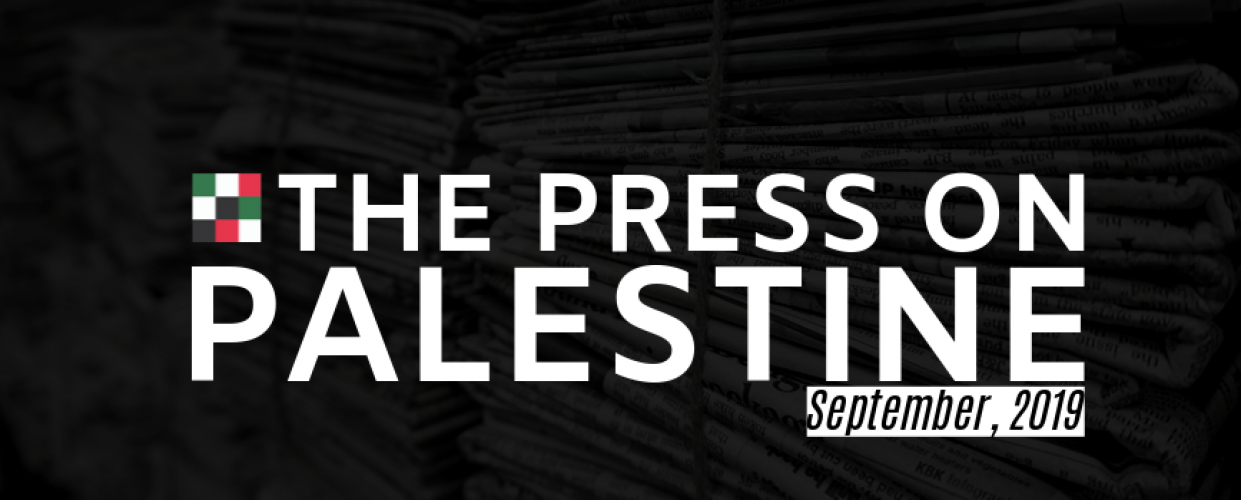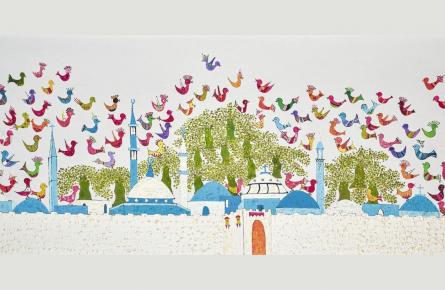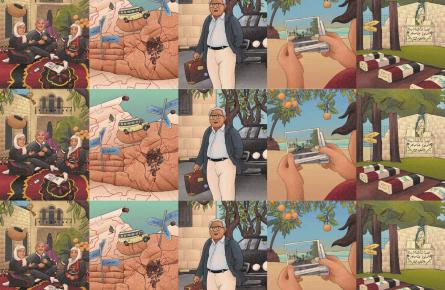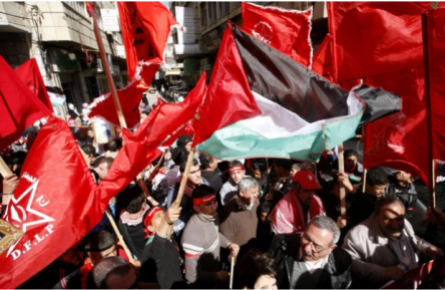This article is part of the Press on Palestine series, an initiative by Palestine Square. It includes selections from September of 2019. Press on Palestine highlights bias in mainstream American reporting on Palestinian affairs and the Arab-Israeli conflict.
NARRATIVE OF CONFLATION
In the span of two weeks, Daniel Gordis has published two articles subtly shaming American Jews for their views on Israel while promoting his new book We Stand Divided: The Rift between American Jews and Israel. . He uses the premise of this book to amplify the consistent bias of the New York Times and the New York Post on Palestinian and Israeli affairs.
- New York Post – Sept. 7, 2019
What American Jews just don’t get about Israel by Daniel Gordis
To assert a foundation for his arguments, Gordis writes that “Netanyahu has been very conflict-avoidant.” Israel has engaged in almost no wars during his long-tenure.” Yet, the 2012 and 2014 Gaza wars, in which thousands of Palestinians were killed and maimed, most of them civilians, clashes at Al-Aqsa mosque in 2015, multiple incidents along the Lebanese border, and scores of targeted air attacks in Lebanon, Syria, and Iraq prove otherwise. The most recent engagement demonstrates the unprecedented and expanded scope of Israeli military activity in a limited period of time. Netanyahu may be surrounded by a team of media professionals capable of spinning his image to the West, but he is as willing to unleash Israel’s armed might as any of his predecessors.
Gordis emphasizes stark differences between the two Jewish groups negating public diplomacy efforts to bring Americans and Israel together. Whereas America welcomes all, Israel is particular to the Jewish people. This raw declaration challenges not only values that American Jews possess, but values Americans uphold. In doing this, Gordis declares Israel’s independence from America and underscores the fundamental contrast between Zionism and the values Americans aspire to. This is particularly the case towards the end of his article where he insinuates that America can never “save” the Jews, only Israel can.
A similar framing bias is apparent when Gordis explains how American Jews view “Israel’s relationship with the Palestinians as a civil-rights issue, [while] Israelis see it as a survival issue.” It is no secret that Israel occupies, exiles, annexes, demolishes, bombs, and exacerbates various aspects of life in Palestine. The “relationship” between Israel and Palestine is neither an issue of civil-rights, nor one of survival, it is one between occupier and occupied, oppressor and oppressed.
Gordis engages in the dehumanization of Palestinians, a staple of every biased approach, when he conflates the end of the occupation with the West Bank becoming “a breeding ground for terrorists.” He does not entertain the prospects of state-building, nor does he respect the presence among Palestinians of technocrats, businessmen, politicians, farmers, students, youth etc. In his vision, the Palestinians must remain permanently subjugated for this spurious reason, and not because their rights are unrecognized, and their land is coveted by the colonizing enterprise that is progressively stealing their homeland.
This dehumanization continues when Gordis justifies Israel’s unchanging policies against Palestinians by citing their “drive to destroy Israel.” Thus, in Gordis’ reading, it is Palestinian resistance to their dispossession that is the problem, rather than this dispossession itself.
- New York Times – Sept. 23, 2019
Benny Gantz Can’t Heal the Rift Between U.S. Jews and Israel by Daniel Gordis
In his second article this month, published by the New York Times, Gordis champions Israel as the savior of Jews from the Arabs, portraying the Arabs as Jew-hating villains. Naturally, he neglects to mention both the Mossad-inspired terrorist attacks in Iraq in 1950 and Egypt in 1954 that triggered the Jewish exodus from these countries, and the long histories of co-existence going back to Muslim Spain before 1492, and the welcome for Jewish refugees from Spain thereafter in North Africa, the Levant and Turkey.
He announces that Judaism is a peoplehood which “became” a religion in America, pitting faith against nationalism. One could argue instead that Judaism “became” a peoplehood in Israel, where the Zionist doctrine prevails against religious teachings.
Gordis reiterates that unless Palestinians “demonstrate,” and not only declare, “an end their drive to destroy” Israel, the occupation will continue. He ignores the history of the PLO’s acceptance of Israel in its 1988 declaration of independence and in the 1993 Oslo accords. Instead he relies on the old chestnut of immutable Arab hostility to Israel, whose main purpose is to divert attention from Israel’s repeated concrete actions aimed at turning what was an Arab country before 1948 into a state exclusively for the Jewish people, through the ethnic cleansing and land theft that began in that year, and the occupation and colonization of what remained of Palestine since the 1967 war..
- New York Times – Aug. 28, 2019
The Israel-Iran Shadow War Escalates and Breaks Into the Open by David Halbfinger, Ben Hubbard, and Ronen Bergman
Three journalists attribute a serious claim about Iran’s military capability to an anonymous Iranian national “with knowledge of Iran’s regional efforts.” The NYT follows a protocol of protecting its sources’ identities if such sources may be at risk by sharing information with the press and if such information is central to the story. Yet, the NYT risks its credibility by omitting clarifying background on its source, especially when the claim being made is used to justify Israel’s attacks across the Middle East late last month. Proper journalistic practice requires an attested explanation. An example of this practice appears towards the end of the article when the authors attribute a similar claim to a “senior Middle Eastern Intelligence official.” In fact, it is probably the case that this intelligence official is Israeli, given Bergman’s background in the Israeli intelligence service, a fact never acknowledged in the piece.
The journalists, clearly placing blame on Iran, criticize the “borderless nature of the Iranian network” but fail to criticize Israel’s violations of the borders and airspace of sovereign nation-states where its attacks took place. Nor anywhere in this item, or in most media coverage of the action of Iran and its allies in Syria and Lebanon, is there any acknowledgement that Israel has nuclear weapons and Iran does not (and is subject to rigorous international inspections to guarantee that it does not develop them); that Israel has repeatedly planned and threatened to attack Iran, and has ample capabilities to do so massively; and that many of Iran’s actions in these arenas are defensive, and aimed at creating a deterrent to prevent Israel from launching any such attack.
FRAMING
- New York Times – Aug. 27, 2019
HBO Drama Revives a National Trauma for Israel by Isabel Kershner
The framing of the title propagates a narrative where Israel is a victim deeply affected by what had been done to it, ignoring how events that prompted an escalation to the 2014 war on Gaza actually took place. Five paragraphs into the story, Kershner mentions Palestinians who “also” had painful memories revived by the HBO series. If so, why not include Palestinian trauma in the headline?
Kershner fails the reader by instigating a pattern of framing that almost always conflates Palestinian with perpetrator or terrorist. Examples follow:
a- “The series, produced by HBO and Israel’s Keshet Studios, dramatizes the 2014 killing of Muhammad Abu Khdeir and the hunt for the unlikely perpetrators.”
Frame: Palestinians are the likely perpetrators. It is not expected that Israeli citizens would have caused harm.
b- “The Shin Bet agents penetrate the closed world of Jerusalem yeshivas to track down the killers – an Orthodox man and his two teenage nephews who lived on the margin of Israeli society and were neither the usual suspects.”
Frame: Again, Israeli citizens who cause harm are on the margins of society. Arabs are the usual suspects.
c- Sourcing Boaz Kukia and Robi Damelin, both parents to deceased Israeli soldiers.
Frame: Kershner provides an opportunity to reaffirm the narrative that places Palestinians at the heart of violence. Kukia’s son “was stabbed to death” and Damelin’s son “was killed by a Palestinian sniper.” The author fails to recount similar stories of Palestinian parents who have experienced the death of their children at the hands of Israeli soldiers, nor of those who have been subjected to arrests and ransacking campaigns by Israelis after the disappearance of the three settlers which sparked the killing of Muhammad Abu Khdeir.
Kershner misses the deeper underlying issue – the dehumanization of Palestinians. Instead, she repeats the narrative of the “anguish” Israelis suffer at the hands of Palestinians, who are always framed as the likely perpetrators
Moreover, nowhere in this article, or anywhere else in the New York Times’ ongoing coverage of violence in Palestine, is there any recognition of the lopsided casualty tolls. In the 2008-09, 2012 and 2014 Israeli assaults on Gaza, a total of 3804 Palestinians were killed, most of them civilians and over 1000 of them minors, as against 87 Israelis, the great majority of them military personnel engaged in attacking Gaza, a ratio of 43:1. This ratio, and other similar ones, should be at the top of every media story about violence between Israelis and Palestinians, unless the operational assumption is that some lives are more valuable than others.




